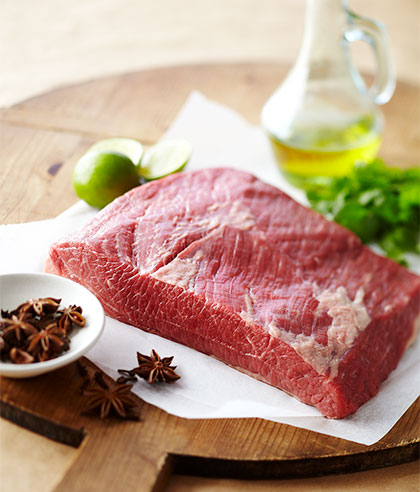About Grass-fed Beef Brisket
This budget-friendly, versatile cut provides a great meal any day of the week. Simply slow-cook and serve with seasonal vegetables or carve the next day for a hearty sandwich. A staple of Southern barbecue, beef brisket shines when slowly smoked to develop a flavorful, caramelized bark. Brisket tends to be tough if cooked quickly, but when cooked low and slow, it develops a delicious flavor.

The cut
The brisket is found in the lower chest or pectoral and comes from a large working muscle that supports a big percentage of body weight. The cut therefore has a significant amount of connective tissue that needs to break down using slow, moist cooking methods such as barbecuing and braising to produce melt-in-the-mouth tender, flavorful meat.
A note on cuts: a whole ‘packer’ cut of brisket contains both the ‘flat’ and ‘point’ cuts. The point cut is triangular and fattier, while the flat cut is more rectangular with a thicker and leaner profile. The point cut lends itself well to applications such as burnt ends, which are glazed and cooked longer to become tender and render more fat. The leaner flat cut can benefit from being chopped or shredded and tossed with barbecue sauce.
How to cook
Best cooking methods – braise, slow cooker, barbecue
For indoor cooking, season then sear the brisket in a frying pan over high heat until well caramelized on both sides. Transfer to a slow cooker or Dutch oven, add beef broth to almost cover the meat, and cook on low (or in a 275 °F oven) for 6-8 hours. The end result should be fork tender.
Regardless of the season or how much time you have to dedicate to cooking, there’s a method for cooking brisket that will work for you. For extra flavorful results, season your brisket the night before and braise it in your oven with this recipe for Southwestern Braised Beef Brisket. A slow cooker produces flavor-packed, hands-off results in this recipe for Slow Cooker BBQ Wagyu Beef Brisket. For a zesty twist on a St. Patrick’s Day tradition, try this recipe for Corned Beef in Ginger Beer that can be made right on your stovetop.
How to cook brisket on the barbecue
When the weather’s warm and barbecue is on your mind, brisket is the perfect low n’ slow cut to feed a crowd. A pellet grill or smoker makes this even more foolproof, but any grill set up for indirect cooking at a low heat (around 225-275°F) will work.
Here is the basic process for smoking a brisket on the barbecue:
- Trim the fat on the fatty side of the brisket using a very sharp knife until it is about ¼” thick, but no less. On the meatier side, remove the web-like membrane (silver skin) so that the coarsely grained meat underneath is visible. Then rub the brisket generously on both sides with salt and pepper (and any additional seasoning you prefer).
- Spray the brisket on both sides with water to make the surface wet. Add wood chunks (or wood chips in a smoking pouch) to the barbecue (apple or oak go nicely), and when smoke appears, place the brisket, fat side down, on the top cooking grate. Close the lid and cook over indirect, very low heat until it has a nice dark crust on the surface (this should take about 4 hours). Aim to keep the heat around 225-250°F during the whole process.
- The surface color of the meat indicates you have created a good ‘bark’, and that the brisket will no longer absorb much smoke. Although color is the primary indication of doneness in this case, you should also check the internal temperature of the meat. It should be somewhere between 150–160°F in the thickest part of the meat.
- Once the brisket has developed a crust and reached temperature, remove from the barbecue and spray it on both sides with water. Then wrap in damp parchment paper before tightly wrapping it in heavy-duty aluminium foil
- Place the wrapped brisket, fat side down, on the top grate of the barbecue. Continue cooking over indirect very low heat, with the lid closed, until the meat is so tender that when you press it with your fingers through the foil, it feels like a giant marshmallow and the internal temperature is 195–203°F, (this should take 2–4 hours or more). Exact cook time will depend on the particular breed of cattle and other characteristics of the beef.
- Transfer the brisket, still wrapped in foil, to a dry, insulated cooler. Close the lid and let the meat rest for 2–4 hours.
- Unwrap the brisket and place it on a cutting board, being careful to keep the precious meat juices in the foil.
- Warm the barbecue sauce over a medium heat on the stove for about 5 minutes. Cut the brisket across the grain into thin slices and serve with as much or as little sauce as you like. If desired, add the meat juices to the sauce. If the meat from the flat is a little dry, coarsely chop it and mix with as much sauce as you like.
